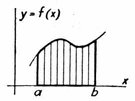
COURSE INFO
SCHEDULE
SYLLABUS
HOMEWORK
WRITING ASSIGNMENTS
OFFICE HOURS
|
Math 126, Spring 2006
Calculus 2
Writing Assignments
Give brief but clear answers to the questions below. Click on this link to send me an email with your answers. Make sure to type 'Calculus Assignment' and the date in the subject line.
For Thursday, January 17
Section 5.1: Areas and Distances
- The examples at the bottom of page 372 give the left and right approximations to the area under the curve y=x2. Which is an over estimate, which is an underestimate, and why?
- How do we obtain more accurate approximations to the area under the curve?
- What are the areas that you feel strongest in from Calculus 1? What areas will you need to work to improve this semester?
For Friday, January 18
Section 5.2: The Definite Integral
- Explain how the definite integral comes about as a limit.
- What nice properties does the definite integral have, similar to some nice properties of the derivative?
- Why does the sign of an integral change if we reverse the limits of integration?
For Tuesday January 22
Section 5.3: The Fundamental Theorem of Calculus
- Why is the calculation in the middle of page 395 (Where f(t)=t, a=0 and g(t) is the integral from 0 to x of f(x) ) valid?
- In the statement of FTC2 (page 398), why does the theorem stipulate that we may choose F to be any antiderivative of f?
- How is taking the area under a curve related to the antiderivative of that curve?
For Thursday, January 24
Section 5.4: Indefinite Integrals and the Net Change Theorem
- What are the differences between the power rules for derivatives and antiderivatives. (If you explain the rules, you should see that you are doing an 'opposite' operation in three places)
- Why do all of our antiderivatives in Table 1 end in +C
- What is the simplification process used for Example 5 on page 407. (Hint: They didn't really do 'long division').
For Friday, January 25
Section 5.5: Integration by Substitution
- In Example 1 on page 415, what key role does the x3 play?
- In Example 7 on page 418, how did the limits of 0 and 4 get changed to the limits 1 and 9?
- Pages 419-420 give a discussion of symmetry, particularly even and odd functions. What kind of function is the product of two even functions? Of two odd functions? Of an even and an odd function? (Hint: Think in terms of polynomials)
For Tuesday January 31
Section 6.1: Areas Between Curves
- How does this section extend the ideas of section 5.1? In other words, how is the finding the area under one curve a special case of finding the area between two curves?
- Why is formula 3 (page 440) stated in terms of absolute values?
- Look at the first four exercises on page 442. For each, determine whether integrating vertically or horizontally will be easier and why. (Use the discussion of example 6 if you're stuck on this one).
Give brief but clear answers to the questions above. Click on this link to send me an email with your answers. Make sure to type 'Calculus Assignment' and the date in the subject line.
Barry Balof's Home Page
Whitman Math Home
Whitman College Home
|
